Near the end of January as my first three-month adventure at Sogetsu Kaikan was drawing to a close I met Mayumi in the elevator of my apartment building. The cultural norm in Japan is not to engage with strangers. It’s assumed that you are content to mind own business and should politely ignore others. But somehow, and I can’t recall who initiated the conversation, we got to chatting.
Learning that we each liked food and drink we exchanged contact information and agreed to meet for coffee or wine or dinner or something. I left everything to Mayumi. As it happened, the day I completed Level 2 she was able to reserve a room for us at Kinari. I had passed the location every day, often casting longing eyes into the glowing rooms hidden by the bamboo at the entrance. However, I knew without being told that it was not a place which would welcome a walk-in.

The approach to Kinari
There we enjoyed a splendid 8 course kaiseki dinner, a serendipitous as well as triumphant celebration of my final day of Sogetsu course work. Alas, with all that leaving Tokyo and re-establishing a life in Victoria afterwards entailed, although I absolutely should have, I never got around to blogging the details.
After my return, once I got settled I dropped a note in Mayumi’s mailbox letting her know I was back in the building. We set a date for lunch. Again, I left everything in her capable hands and she introduced me to Abysse, a restaurant focused on seafood and seasonal Japanese vegetables prepared in the French style under Chef Kotaro Meguro. Still in his early thirties, he has already managed to snag a Michelin star in his second year of operation.
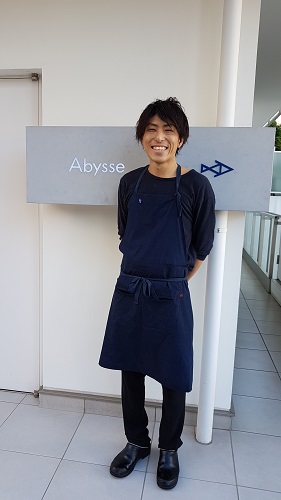
Chef Kotaro Meguro in front of his restaurant
As is often the case in Japan, the establishment shows few visible signs of existence from the street. To find it, you need to be in the know. In the case of Abysse, a discrete name plate against a white wall is all you see. The doorway is down a narrow balcony to the right, and if it were not for the long handle, it would be hard to know there was a door at all. That’s how well it blends into the wall.
The sophisticated Abysse interior is black and softly lit. Enough tables for twelve diners are set with fine linens, stemware and glass plates in clear and smoke-gray hues. A small private room is tucked into the back.
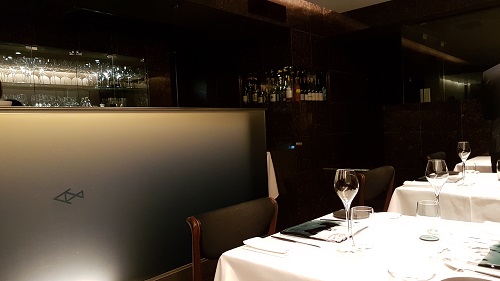
Teppei Fujimura who seated us inquired about any allergies we might have so that the kitchen might make the needed adjustments. He then explained that their luncheon menu was set by Chef Meguro. An amuse bouche of Conger eel on roasted cacao chips would be followed by six courses which were described on individual menu cards he left at the table.
We didn’t opt for the full wine-pairings offered, but deferred to Fujimura-san’s expertise for wines by the glass–a Sancerre and a Pinot Noir–as well.
The amuse bouche was followed by the first appetizer. Squid from Kanagawa with Hasu-Imo, Makomotake, Italian flat beans, dill and mascarpone.
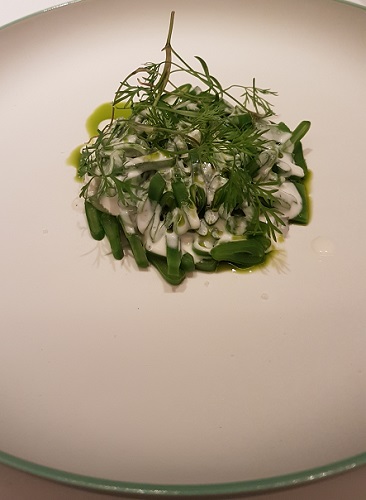
The second appetizer: Mussels from Hokkaido with ground cherry, sea bream broth and truffle.

The third appetizer: Sanma (pike) from Kanagawa with wild Enoki mushrooms, Hebesu (Japanese citrus) and pecan nuts.
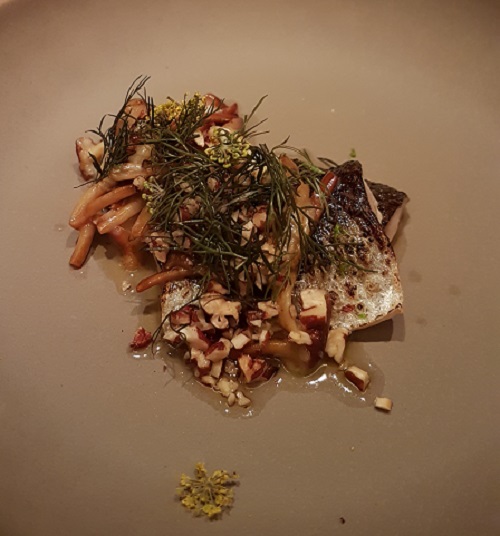
Oops! I forgot to snap the main feature: Kuro-Mutsu (Blue-fish) from Kagoshima with black garlic, black olives, trumpet mushrooms and taro.
The first dessert course, likewise. The date sweetened rice pudding sprinkled with macadamia nuts and chestnuts wouldn’t have photographed well even if I had remembered to do it.
The second dessert course: Figs with blue cheese ice powder, sablé and blueberry.
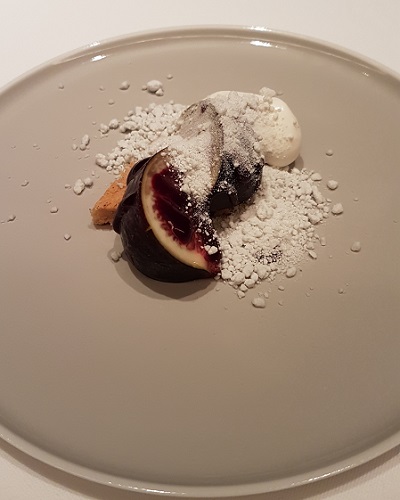
In a world where multiple specifications regarding personal food or drink choices are the norm, there is a divine sense of being taken care of when no decisions of any kind are required. Instead, for three hours we trusted ourselves to the exemplary care of masterful professionals, artists in their own right.
After lingering over chocolate and coffee we said our farewells and wandered out into the sunny autumnal afternoon. Satiated. Serene. Smiling.
